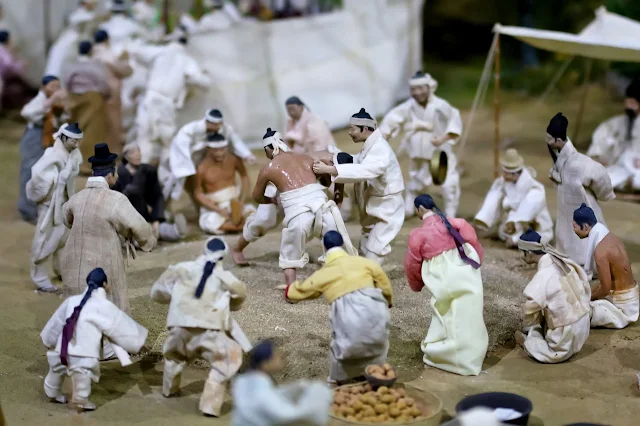
Ssireum is a folk wrestling style and traditional national sport of Korea that dates back to the fourth century.
It is a form of entertainment and cultural heritage showcasing the Korean people's strength, skill, and spirit.
In this article, we will explore the history, rules, techniques, and popularity of ssireum.
{tocify} $title={Table of Contents}
History of Ssireum
According to some sources, ssireum originated in the Goguryeo period (37 BC – 668 AD) as a military training method and a way of settling disputes among soldiers.
It later became a popular pastime among the common people, especially during festivals and holidays.
Many Korean kings, such as Gwangjong of Goryeo (949 – 975) and Yeongjo of Joseon (1694 – 1776), were also fond of ssireum and encouraged its development.
Ssireum has been known by various names throughout history, such as gakjeo, gakhui, gakryeok, gakji, chiuhui, sangbak and jaenggyo.
The term ssireum, which means "wrestling" in Korean, was adopted in the 1920s.
The first modern competition was held in 1912 at the Dansongsa Theater in Seoul, and the Pan Chosun Ssireum Federation was founded in 1927.
Since 1947, the competition organized by the Ssireum Federation has been called the National Ssireum Championship Contest.
In 2018, ssireum was inscribed on the UNESCO Representative List of the Intangible Cultural Heritage of Humanity as a joint nomination by North Korea and South Korea.
The inscription recognized ssireum as "a popular form of entertainment widely enjoyed across the Korean peninsula that also serves as a means of promoting dialogue and unity among communities."
Rules of Ssireum
Ssireum is a type of wrestling in which two contestants wear long fabric belts (satba) wrapped around their waist and thighs.
The belts are usually made of cotton or hemp and are colored red or blue to distinguish the opponents.
The contestants face each other inside a circular sandpit (jangsa) that measures about 7 meters in diameter.
The referee (gyeji) signals the start and end of the match with a horn (nabal).
The objective of ssireum is to bring any part of the opponent's body above the knee to the ground using various techniques such as pushing, pulling, lifting, tripping, and throwing.
The contestants are allowed to grip each other's belt or thigh, but not other parts of the body or clothing.
The match consists of three rounds, each lasting three minutes, with a one-minute break between rounds.
The contestant who wins two rounds out of three is declared the winner. If neither contestant wins a round within the time limit, the round is declared a draw and repeated until a winner is decided.
Techniques of Ssireum
Ssireum employs a series of techniques that inflict little harm or injury to the opponent.
Some of the common techniques are:
- Jwibulnori (쥐불놀이): A technique that involves twisting the opponent's belt to make them lose balance and fall.
- Ppaegeori (빼거리): A technique that involves lifting the opponent's leg with one's own leg and pushing them down.
- Gulleogi (굴러기): A technique that involves rolling over with the opponent on top and reversing their position.
- Japgi (잡기): A technique that involves grabbing the opponent's thigh and throwing it over one's shoulder.
- Baekdongi (백동이): A technique that involves pushing the opponent backward with both hands until they fall.
- Naseogi (나서기): A technique that involves stepping forward and pushing the opponent with one's chest or shoulder.
- Doraegi (도래기): A technique that involves pulling the opponent toward oneself and throwing them sideways.
- Geomjeogi (검저기): A technique that involves hooking one's leg behind the opponent's leg and tripping them.
There are also variations and combinations of these techniques depending on the situation and strategy of the contestants.
Popularity of Ssireum
Ssireum is a widely enjoyed sport in Korea that attracts people of all ages, genders, and backgrounds.
It is especially popular during traditional holidays such as Dano (the fifth day of the fifth lunar month), Chuseok (the harvest festival), and Seollal (the lunar new year).
Ssireum tournaments are held at various levels, from local to national, and often offer prizes such as rice, livestock, or money.
The traditional prize at a tournament was an ox, a valuable commodity in an agriculturally based society and a symbol of the strength of the contestant.
Ssireum is also a nationally televised sport in South Korea, with regular broadcasts and coverage by major media outlets.
Some of the famous ssireum champions in South Korea include Kang Ho-dong, Lee Man-ki, Kim Il, and Choi Hong-man.
Ssireum has also influenced other forms of martial arts and sports, such as judo, sumo, and mixed martial arts.
Ssireum is not only a sport, but also a cultural expression that reflects the values and identity of the Korean people.
It is a way of celebrating life, honoring ancestors, respecting opponents, and promoting harmony among communities.
Ssireum is a living heritage that continues to evolve and adapt to the changing times while preserving its essence and spirit.

Post a Comment